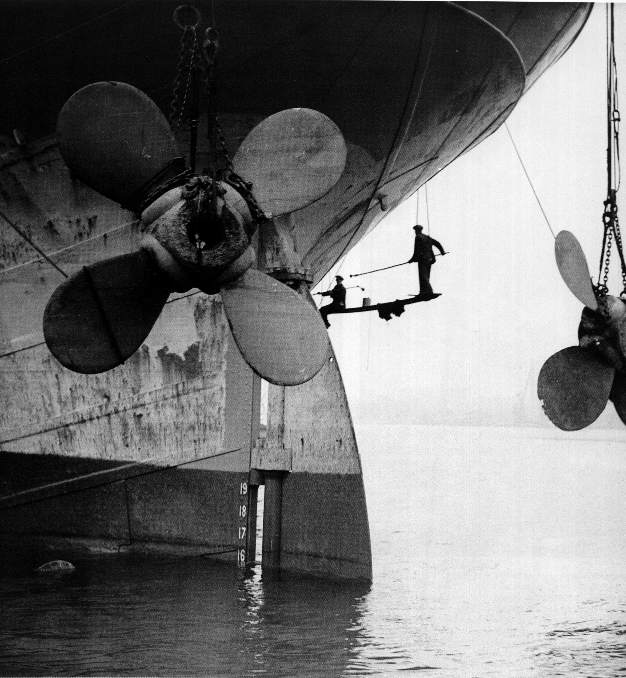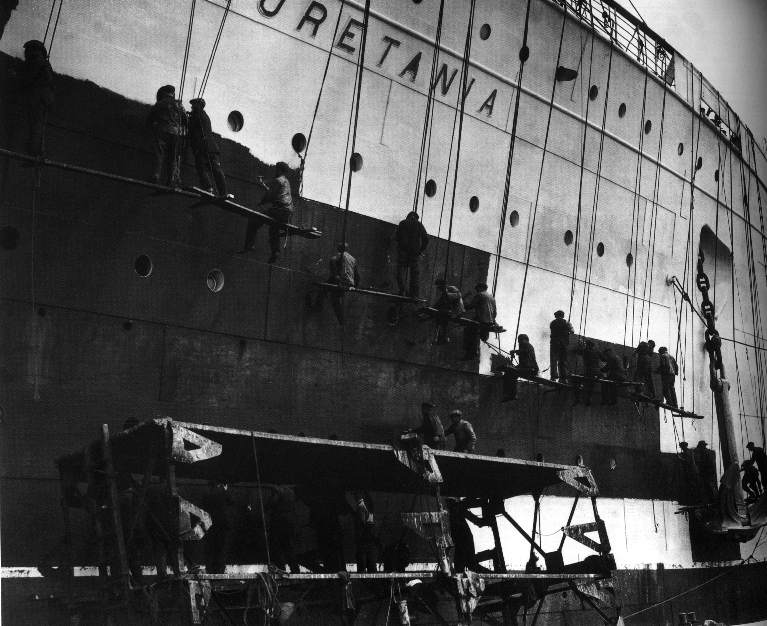|
Many times on the message boards, there have been
questions about the paint used on the Titanic as well as
other Ocean Liners of the 1912 era in general. Some
of the information that was given out, and is true, is that
the paint of the period was made of lead powder mixed with
linseed oil. In fact, paint is naturally glossy. Paint
requires an additive to make it flat. At the time
the Titanic was built, one did not go down to the local
marina and buy a five gallon drum of paint, they mixed it
by hand. In the Titanic's case, Harland andWolff had
their own paint mixing shed.
The colors used on the ships of the day were common
colors as the pigments re simple. When reading the
text below, which was transcribed from a copy of the "Merchant
Marine Officer's Handbook", take notice of the common
earth toned pigments. Notice that they are blacks,
yellows, blues, greens and reds. This article may
be overkill to get the point across, but I feel it is interesting
to see how paint was made in the period. Remember
that the terms of red lead and white lead do not necessarily
mean the color of the paint.
Rather, it is they are merely pigments for mixing colors.
However, the anti fowling paint of the hull is a red oxide.
Red oxide is real close to red Rustoleum primer. It
has been said that the red Rustoleum metal primer is actually
a hold over from these days of shipping, and anti fowling
paint.

Manhelpers are used to paint inaccessible places, usually
a ship's side, when stagings are not practical. When
vessels are berthed along side a dock, much of the works
done from the dock or from work boats. Manhelpers
are rarely used on deck as no part of deck structures should
be considered inaccessible to a seaman. Manhelpers
are usually 10' or over in length, the brush being fastened
by yarns to a notch cut about 3" from the end, the
brush secured at an angle of about 45 degrees to the shank.
Paint is made up of two principle parts, the pigment and
the vehicle. Pigment of paint may be defined as the minute
particles of insoluble solids that form the body of the
paint and remain as the hard opaque surface after the liquid
or vehicle had evaporated or deteriorated. Vehicle of paint
is the liquid content which acts as a binding agent between
the minute particles of pigment, holding them together as
well as to the surface of an object. The Vehicle also
contains the drying agent. Vehicles are as definitely
liquids as pigments are solids.
PIGMENTS
Red Leads come in two basic forms, reddish powder and heavy
paste. As red lead and white lead and zinc form the
base of most paint it may be well to discuss briefly just
what they are an how they are made.
Red Lead (Oxide of Lead) is made made from metallic lead,
by a burning process. Lead melts easily at 620 degrees
F, but in this burning process the temperature is boosted
to 900 degrees to 1200 degrees F at which oxygen is included
into the lead producing an oxidizing effect and the resultant
compound is the bright reddish powder that we know of as
red lead.
White Leads (Basic Carbonite) White Lead is made made by
separate processes; in the first, metallic lead is corroded
by acetic acid forming whitish flakes, which are later ground
to a fine powder. This is sold either in this form or as
paste, the latter being more favored. The second process
(Basic Sulfate) of making white leads is from lead sulfide
ore by the sublimation process. The process which
resembles that of making red lead, in the the ore is roasted,
the fumes mixing with oxygen forming the white powder we
know as white lead.
Zinc Oxide is a compound of zinc and oxygen, and is the
finest of all white pigments. Due to its extreme hardness
zinc oxide is unaffected by either change of temperature
or the gasses present in the atmosphere. Zinc oxide
is used in making white enamels and may be combined with
white lead or other pigments.
COLOR PIGMENTS
Color pigments are added to the base pigment to
give color to paint. They are made principally from
mineral or natural earth colors and from chemical colors.
The most common natural earth pigments are siennas, umbers,
yellow ochre, and various mineral blacks. The most
common chemical colors are chrome yellow, Prussian blue,
chrome green, cobalt blue and vermillion.
Carbon Blacks, Lampblack, gas black and graphite
are the most common carbon blacks in use aboard ships today.
They are pigments of pure ingredients and in themselves
will make a very durable paint but their best use is to
tint white, red or zinc lead to get a desired shade and
because of their extreme opaque quality only a small amount
is required with leads to make an excellent black paint.
Drip black, bone black, ivory black and other blacks of
this type are also carbon products but as they are made
from animal and vegetable matter they are naturally of an
inferior quality and strength therefore about five times
greater amount than carbon black should be used. For
tinting purposes these blacks should not be added while
in their dry state but mixed with a small amount of linseed
oil. All blacks have a non-drying tendency and when
used as pure pigment more dryers must be added.
VEHICLES
Linseed Oil. The most common vehicle used
today in mixing paint is linseed oil. It is obtained
from crushed flaxseed and is a natural product. For
mixing of paint it is prepared in two forms, the first,
raw oil which is is the product in its natural state.
The second boiled oil, is produced from the raw oil by dissolving
certain drying compounds into it. These compounds
may be maganese and lead oxide or cobalt and as they are
dissolved by a heat process the term boiled oil has become
widely used. Boiled oil is somewhat thicker than raw
oil and a shade darker, and since it has been more or less
oxidized in its manufacture, has a quicker drying action.
Therefore when using boiled oil the amount of dryers can
be reduced considerably or may be omitted entirely.
It would be useless to rewrite all of the paint formulas
in this book, as they are in pounds of powder mixed
to numerous gallons of oil. I will reprint
the pertinent information that would help one understand
the colors used aboard an Ocean Liner of the 1912 era.
"Outside White" The following formula
for finishing coats of white has found much
favor aboard ships.
White Lead 5 lbs.
Turpentine 3 gills
White Zinc 9 lbs.
Dryers
7 ounces
Raw oil 3 pints
"Hull Black" can be made with a red lead base
by using the
following formula, which will make approximately one gallon
of
paint:
Redlead paste
4.25 lbs.
Raw linseed oil .375 gal.
Carbon black in oil .327 gal.
Turpentine .058 gal.
Prussian blue in oil .085 gal.
Dryers
.058 gal.
"Light Gray" is a neutral color and is heavily
used in maritime painting, many ships using it to paint
their hull, house, sun decks, lifeboat interiors, etc.
Though the original paints of the great Ocean Liners
was glossy, this does not mean that you would paint your
models in glossy paint. In order to paint your ship
to look in scale, it musty be flat. This is usually
achieved with a final application of Dull Coat, or some
other product.

|